Organizational Change Management Report: CHEO Hospital Analysis
VerifiedAdded on 2023/06/03
|17
|4912
|430
Report
AI Summary
This report analyzes the change management process at The Children’s Hospital of Eastern Ontario (CHEO), specifically focusing on the transition from a manual patient records system to an electronic medical record (EMR) system. The report explores the purpose and scope of the change, highlighting the shift mandated by government policy. It defines organizational change, differentiating between transitional and transformational change, with CHEO's EMR implementation classified as a planned transitional change. The report applies Lewin's force field analysis model to identify forces driving and resisting change, supported by SWOT and PESTEL analyses. Forces for change include government policy, increased efficiency, and technological opportunities, while forces against change are not explicitly detailed but are implied by the analysis. The report concludes with recommendations based on the force field analysis, emphasizing the importance of a strategic approach to manage organizational change effectively. The analysis covers various aspects of the change, including the hospital's change management plan, the use of a systematic approach to support clients, and the integration of best practices. The report also discusses the benefits of the EMR system, such as improved service delivery, increased efficiency, and enhanced patient care. The report emphasizes the importance of proper mechanisms to address change and the need for a change management plan to guide the implementation process.

Name 1
Change Management in The Children’s Hospital of Eastern Ontario’s
Student’s Name
University
Date
Course
Instructor
Change Management in The Children’s Hospital of Eastern Ontario’s
Student’s Name
University
Date
Course
Instructor
Paraphrase This Document
Need a fresh take? Get an instant paraphrase of this document with our AI Paraphraser
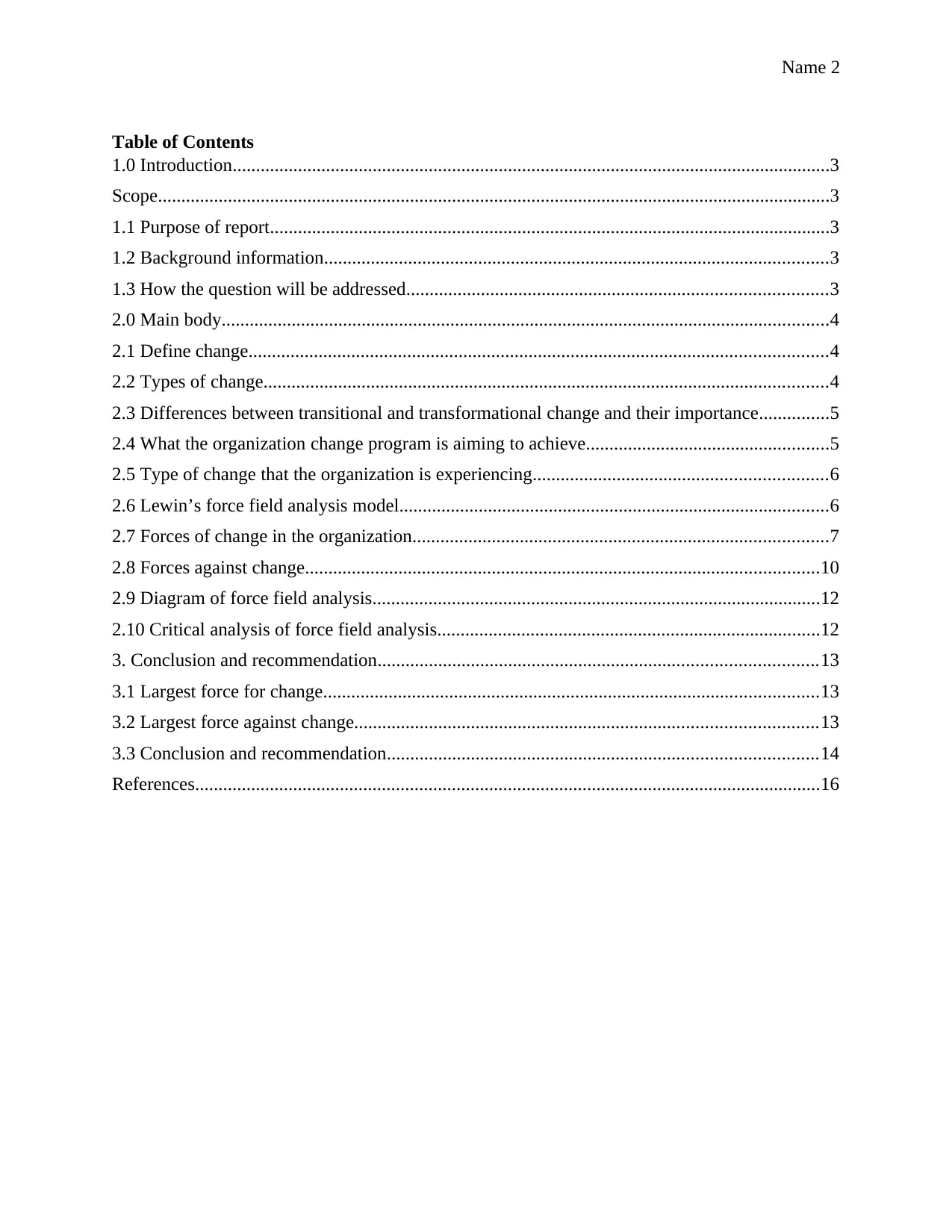
Name 2
Table of Contents
1.0 Introduction................................................................................................................................3
Scope................................................................................................................................................3
1.1 Purpose of report........................................................................................................................3
1.2 Background information............................................................................................................3
1.3 How the question will be addressed..........................................................................................3
2.0 Main body..................................................................................................................................4
2.1 Define change............................................................................................................................4
2.2 Types of change.........................................................................................................................4
2.3 Differences between transitional and transformational change and their importance...............5
2.4 What the organization change program is aiming to achieve....................................................5
2.5 Type of change that the organization is experiencing...............................................................6
2.6 Lewin’s force field analysis model............................................................................................6
2.7 Forces of change in the organization.........................................................................................7
2.8 Forces against change..............................................................................................................10
2.9 Diagram of force field analysis................................................................................................12
2.10 Critical analysis of force field analysis..................................................................................12
3. Conclusion and recommendation..............................................................................................13
3.1 Largest force for change..........................................................................................................13
3.2 Largest force against change...................................................................................................13
3.3 Conclusion and recommendation............................................................................................14
References......................................................................................................................................16
Table of Contents
1.0 Introduction................................................................................................................................3
Scope................................................................................................................................................3
1.1 Purpose of report........................................................................................................................3
1.2 Background information............................................................................................................3
1.3 How the question will be addressed..........................................................................................3
2.0 Main body..................................................................................................................................4
2.1 Define change............................................................................................................................4
2.2 Types of change.........................................................................................................................4
2.3 Differences between transitional and transformational change and their importance...............5
2.4 What the organization change program is aiming to achieve....................................................5
2.5 Type of change that the organization is experiencing...............................................................6
2.6 Lewin’s force field analysis model............................................................................................6
2.7 Forces of change in the organization.........................................................................................7
2.8 Forces against change..............................................................................................................10
2.9 Diagram of force field analysis................................................................................................12
2.10 Critical analysis of force field analysis..................................................................................12
3. Conclusion and recommendation..............................................................................................13
3.1 Largest force for change..........................................................................................................13
3.2 Largest force against change...................................................................................................13
3.3 Conclusion and recommendation............................................................................................14
References......................................................................................................................................16
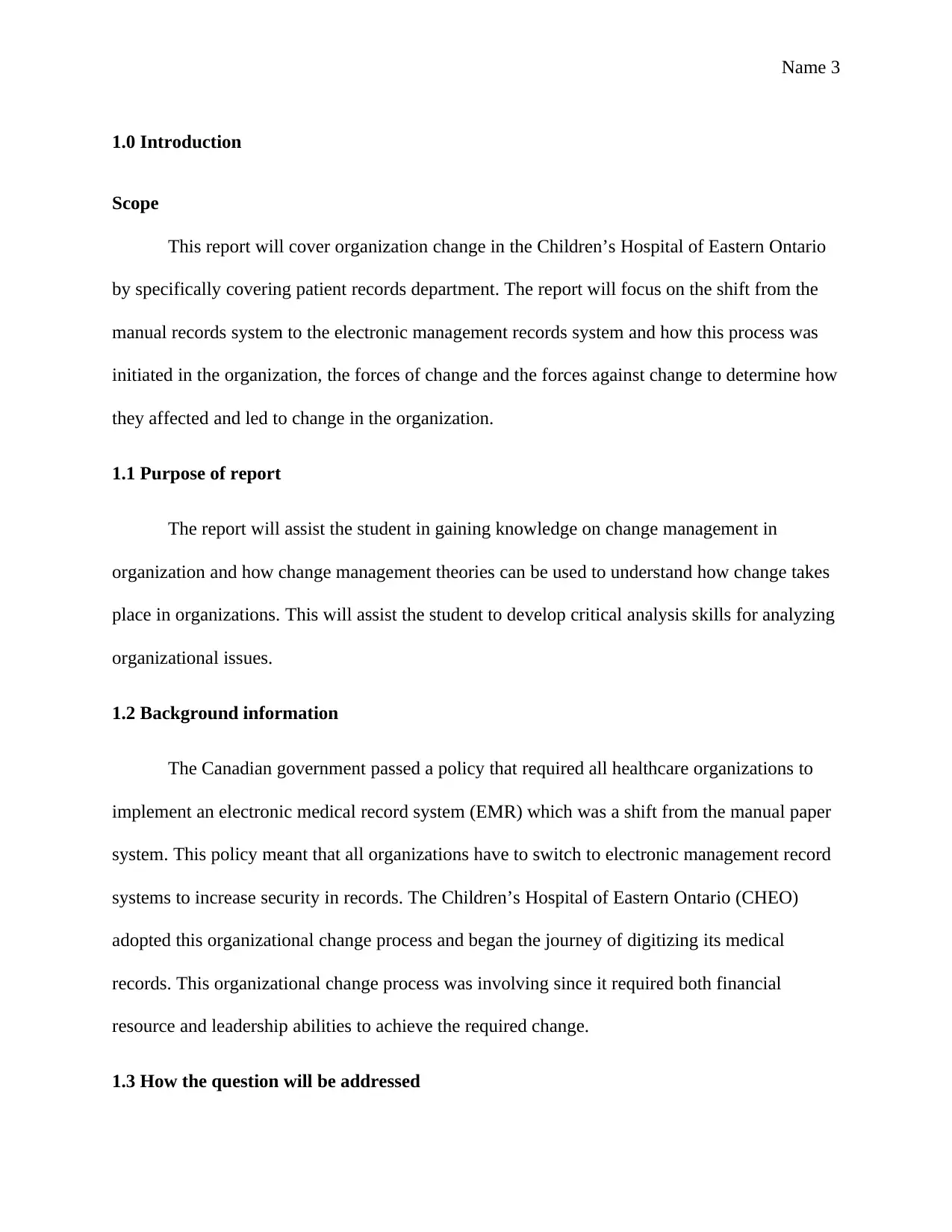
Name 3
1.0 Introduction
Scope
This report will cover organization change in the Children’s Hospital of Eastern Ontario
by specifically covering patient records department. The report will focus on the shift from the
manual records system to the electronic management records system and how this process was
initiated in the organization, the forces of change and the forces against change to determine how
they affected and led to change in the organization.
1.1 Purpose of report
The report will assist the student in gaining knowledge on change management in
organization and how change management theories can be used to understand how change takes
place in organizations. This will assist the student to develop critical analysis skills for analyzing
organizational issues.
1.2 Background information
The Canadian government passed a policy that required all healthcare organizations to
implement an electronic medical record system (EMR) which was a shift from the manual paper
system. This policy meant that all organizations have to switch to electronic management record
systems to increase security in records. The Children’s Hospital of Eastern Ontario (CHEO)
adopted this organizational change process and began the journey of digitizing its medical
records. This organizational change process was involving since it required both financial
resource and leadership abilities to achieve the required change.
1.3 How the question will be addressed
1.0 Introduction
Scope
This report will cover organization change in the Children’s Hospital of Eastern Ontario
by specifically covering patient records department. The report will focus on the shift from the
manual records system to the electronic management records system and how this process was
initiated in the organization, the forces of change and the forces against change to determine how
they affected and led to change in the organization.
1.1 Purpose of report
The report will assist the student in gaining knowledge on change management in
organization and how change management theories can be used to understand how change takes
place in organizations. This will assist the student to develop critical analysis skills for analyzing
organizational issues.
1.2 Background information
The Canadian government passed a policy that required all healthcare organizations to
implement an electronic medical record system (EMR) which was a shift from the manual paper
system. This policy meant that all organizations have to switch to electronic management record
systems to increase security in records. The Children’s Hospital of Eastern Ontario (CHEO)
adopted this organizational change process and began the journey of digitizing its medical
records. This organizational change process was involving since it required both financial
resource and leadership abilities to achieve the required change.
1.3 How the question will be addressed
⊘ This is a preview!⊘
Do you want full access?
Subscribe today to unlock all pages.

Trusted by 1+ million students worldwide
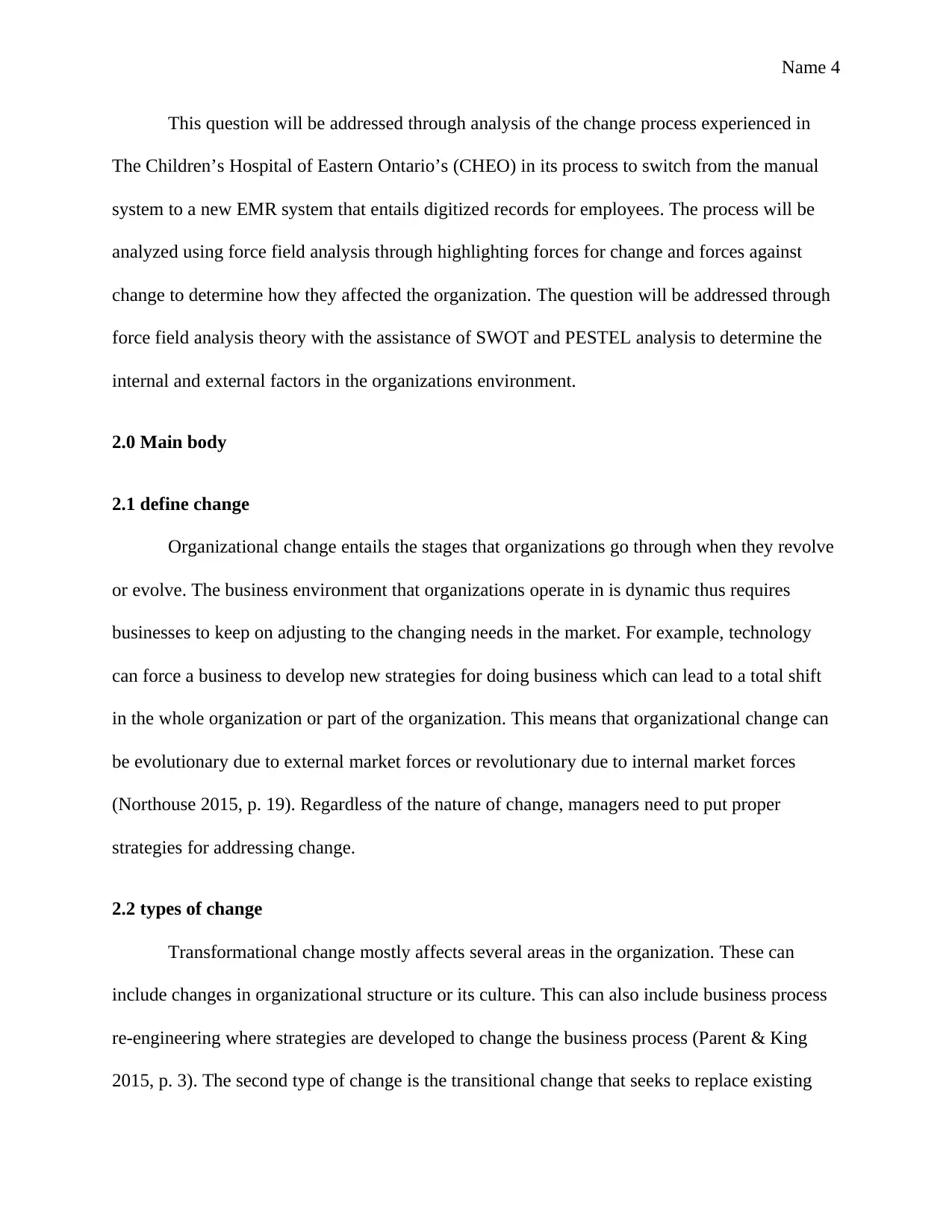
Name 4
This question will be addressed through analysis of the change process experienced in
The Children’s Hospital of Eastern Ontario’s (CHEO) in its process to switch from the manual
system to a new EMR system that entails digitized records for employees. The process will be
analyzed using force field analysis through highlighting forces for change and forces against
change to determine how they affected the organization. The question will be addressed through
force field analysis theory with the assistance of SWOT and PESTEL analysis to determine the
internal and external factors in the organizations environment.
2.0 Main body
2.1 define change
Organizational change entails the stages that organizations go through when they revolve
or evolve. The business environment that organizations operate in is dynamic thus requires
businesses to keep on adjusting to the changing needs in the market. For example, technology
can force a business to develop new strategies for doing business which can lead to a total shift
in the whole organization or part of the organization. This means that organizational change can
be evolutionary due to external market forces or revolutionary due to internal market forces
(Northouse 2015, p. 19). Regardless of the nature of change, managers need to put proper
strategies for addressing change.
2.2 types of change
Transformational change mostly affects several areas in the organization. These can
include changes in organizational structure or its culture. This can also include business process
re-engineering where strategies are developed to change the business process (Parent & King
2015, p. 3). The second type of change is the transitional change that seeks to replace existing
This question will be addressed through analysis of the change process experienced in
The Children’s Hospital of Eastern Ontario’s (CHEO) in its process to switch from the manual
system to a new EMR system that entails digitized records for employees. The process will be
analyzed using force field analysis through highlighting forces for change and forces against
change to determine how they affected the organization. The question will be addressed through
force field analysis theory with the assistance of SWOT and PESTEL analysis to determine the
internal and external factors in the organizations environment.
2.0 Main body
2.1 define change
Organizational change entails the stages that organizations go through when they revolve
or evolve. The business environment that organizations operate in is dynamic thus requires
businesses to keep on adjusting to the changing needs in the market. For example, technology
can force a business to develop new strategies for doing business which can lead to a total shift
in the whole organization or part of the organization. This means that organizational change can
be evolutionary due to external market forces or revolutionary due to internal market forces
(Northouse 2015, p. 19). Regardless of the nature of change, managers need to put proper
strategies for addressing change.
2.2 types of change
Transformational change mostly affects several areas in the organization. These can
include changes in organizational structure or its culture. This can also include business process
re-engineering where strategies are developed to change the business process (Parent & King
2015, p. 3). The second type of change is the transitional change that seeks to replace existing
Paraphrase This Document
Need a fresh take? Get an instant paraphrase of this document with our AI Paraphraser

Name 5
organizational processes with the new ones. This process can be planned or unplanned, for
example the change witnessed in the process is transitional change since the organization seeks
to develop strategies for addressing the challenges that the Canadian government presents
through the new policies.
2.3 differences between transitional and transformational change and their importance
The major difference between transitional and transformational change is that in
transitional change the process can be planned by the organization or can be a result of external
forces like policies while transformational change entails an overhaul of the whole organization
to meet different needs that the organization can be facing.
2.4 What the organization change program is aiming to achieve
The purpose of this new change strategy was to improve service delivery to all
outpatients by increasing quality access and consistent clinical documentation. When patients
are achieving quality services, then efficiency is achieved due to increased service delivery. This
process started by scheduling and registering all patients in the Epic system by 2014 thus
allowing all laboratory results to be viewed in the system, and also ensuring that all healthcare
providers who work with the hospital have access to the Epic system for viewing patient results
and any clinical documentation for a particular patient. This process also allows ordering of
medications through mobile applications since patients can search within the system to determine
what they require and place their request without necessarily visiting the facility.
To achieve this process effectively, the organization used a systematic approach to
support its clients through the anticipated change process and applying a culture of continuous
improvement from the patient’s feedback. When the system was launched, patients were required
to give feedback on the efficiency of the system or the challenges they face when using the
organizational processes with the new ones. This process can be planned or unplanned, for
example the change witnessed in the process is transitional change since the organization seeks
to develop strategies for addressing the challenges that the Canadian government presents
through the new policies.
2.3 differences between transitional and transformational change and their importance
The major difference between transitional and transformational change is that in
transitional change the process can be planned by the organization or can be a result of external
forces like policies while transformational change entails an overhaul of the whole organization
to meet different needs that the organization can be facing.
2.4 What the organization change program is aiming to achieve
The purpose of this new change strategy was to improve service delivery to all
outpatients by increasing quality access and consistent clinical documentation. When patients
are achieving quality services, then efficiency is achieved due to increased service delivery. This
process started by scheduling and registering all patients in the Epic system by 2014 thus
allowing all laboratory results to be viewed in the system, and also ensuring that all healthcare
providers who work with the hospital have access to the Epic system for viewing patient results
and any clinical documentation for a particular patient. This process also allows ordering of
medications through mobile applications since patients can search within the system to determine
what they require and place their request without necessarily visiting the facility.
To achieve this process effectively, the organization used a systematic approach to
support its clients through the anticipated change process and applying a culture of continuous
improvement from the patient’s feedback. When the system was launched, patients were required
to give feedback on the efficiency of the system or the challenges they face when using the

Name 6
system and propose the changes that they felt could correct the system. This system also adopted
best practices from other institutions that had implemented the framework and adopting them
into the organization (Hayes 2014, p. 12). The hospital developed a change management plan to
document all the organizational processes and develop ways of ensuring the process was
successful. This was through a document that outlined existing quality management frameworks
in the hospital and ensured that they were integrated into the new system while following all
government regulations set in the industry.
Further, Kotter (2012, p. 62) suggests that successful change processes in organizations
must be managed with a proper strategy that guides the way the process is implemented. Without
this, the change process can fail due to system deficiencies that were not corrected and aligned
with the new system structure that the organization process creates. Since change creates tension
and destabilizes the existing status quo, proper mechanism have to be in place to address such
challenges. In this change process, there was need to develop a change management plan
detailing how different aspects of the process like transition and adoption will be implemented
(Fiorio, Gorli, Verzillo 2018, p. 5). This required the service a project management team charged
with the responsibility of initiating the change process and change control. Here the team used a
readiness and adoption strategy when dealing with people and change. This allowed activities to
take place at multiple levels of project implementation until it was completed.
2.5 Type of change that the organization is experiencing
The Children’s Hospital of Ontario is experiencing planned transitional change due to the
need to comply with the requirements of the Canadian policies. This process has led to the
transformation of the records department in the whole organization to replace it with the digital
system to increase patient data safety.
system and propose the changes that they felt could correct the system. This system also adopted
best practices from other institutions that had implemented the framework and adopting them
into the organization (Hayes 2014, p. 12). The hospital developed a change management plan to
document all the organizational processes and develop ways of ensuring the process was
successful. This was through a document that outlined existing quality management frameworks
in the hospital and ensured that they were integrated into the new system while following all
government regulations set in the industry.
Further, Kotter (2012, p. 62) suggests that successful change processes in organizations
must be managed with a proper strategy that guides the way the process is implemented. Without
this, the change process can fail due to system deficiencies that were not corrected and aligned
with the new system structure that the organization process creates. Since change creates tension
and destabilizes the existing status quo, proper mechanism have to be in place to address such
challenges. In this change process, there was need to develop a change management plan
detailing how different aspects of the process like transition and adoption will be implemented
(Fiorio, Gorli, Verzillo 2018, p. 5). This required the service a project management team charged
with the responsibility of initiating the change process and change control. Here the team used a
readiness and adoption strategy when dealing with people and change. This allowed activities to
take place at multiple levels of project implementation until it was completed.
2.5 Type of change that the organization is experiencing
The Children’s Hospital of Ontario is experiencing planned transitional change due to the
need to comply with the requirements of the Canadian policies. This process has led to the
transformation of the records department in the whole organization to replace it with the digital
system to increase patient data safety.
⊘ This is a preview!⊘
Do you want full access?
Subscribe today to unlock all pages.

Trusted by 1+ million students worldwide
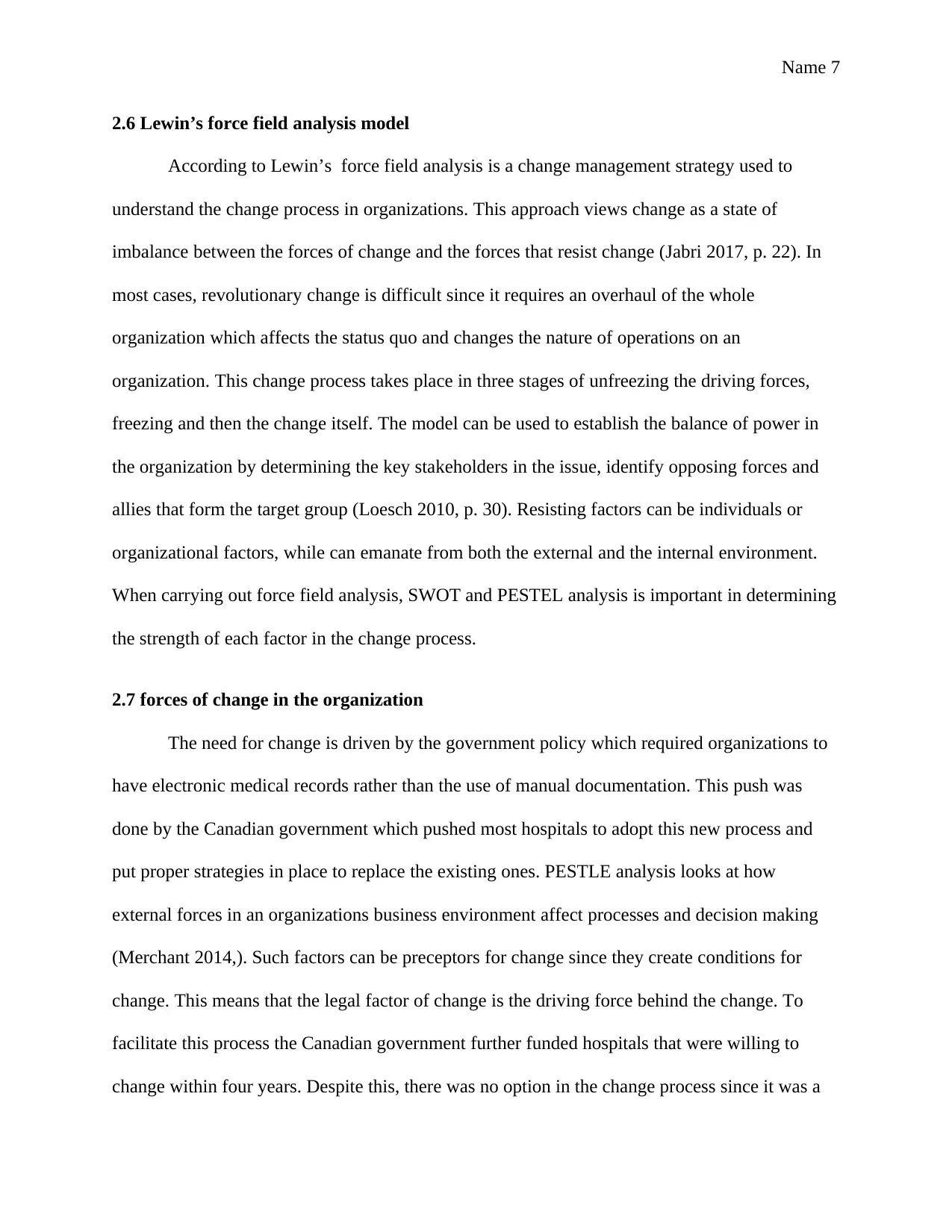
Name 7
2.6 Lewin’s force field analysis model
According to Lewin’s force field analysis is a change management strategy used to
understand the change process in organizations. This approach views change as a state of
imbalance between the forces of change and the forces that resist change (Jabri 2017, p. 22). In
most cases, revolutionary change is difficult since it requires an overhaul of the whole
organization which affects the status quo and changes the nature of operations on an
organization. This change process takes place in three stages of unfreezing the driving forces,
freezing and then the change itself. The model can be used to establish the balance of power in
the organization by determining the key stakeholders in the issue, identify opposing forces and
allies that form the target group (Loesch 2010, p. 30). Resisting factors can be individuals or
organizational factors, while can emanate from both the external and the internal environment.
When carrying out force field analysis, SWOT and PESTEL analysis is important in determining
the strength of each factor in the change process.
2.7 forces of change in the organization
The need for change is driven by the government policy which required organizations to
have electronic medical records rather than the use of manual documentation. This push was
done by the Canadian government which pushed most hospitals to adopt this new process and
put proper strategies in place to replace the existing ones. PESTLE analysis looks at how
external forces in an organizations business environment affect processes and decision making
(Merchant 2014,). Such factors can be preceptors for change since they create conditions for
change. This means that the legal factor of change is the driving force behind the change. To
facilitate this process the Canadian government further funded hospitals that were willing to
change within four years. Despite this, there was no option in the change process since it was a
2.6 Lewin’s force field analysis model
According to Lewin’s force field analysis is a change management strategy used to
understand the change process in organizations. This approach views change as a state of
imbalance between the forces of change and the forces that resist change (Jabri 2017, p. 22). In
most cases, revolutionary change is difficult since it requires an overhaul of the whole
organization which affects the status quo and changes the nature of operations on an
organization. This change process takes place in three stages of unfreezing the driving forces,
freezing and then the change itself. The model can be used to establish the balance of power in
the organization by determining the key stakeholders in the issue, identify opposing forces and
allies that form the target group (Loesch 2010, p. 30). Resisting factors can be individuals or
organizational factors, while can emanate from both the external and the internal environment.
When carrying out force field analysis, SWOT and PESTEL analysis is important in determining
the strength of each factor in the change process.
2.7 forces of change in the organization
The need for change is driven by the government policy which required organizations to
have electronic medical records rather than the use of manual documentation. This push was
done by the Canadian government which pushed most hospitals to adopt this new process and
put proper strategies in place to replace the existing ones. PESTLE analysis looks at how
external forces in an organizations business environment affect processes and decision making
(Merchant 2014,). Such factors can be preceptors for change since they create conditions for
change. This means that the legal factor of change is the driving force behind the change. To
facilitate this process the Canadian government further funded hospitals that were willing to
change within four years. Despite this, there was no option in the change process since it was a
Paraphrase This Document
Need a fresh take? Get an instant paraphrase of this document with our AI Paraphraser
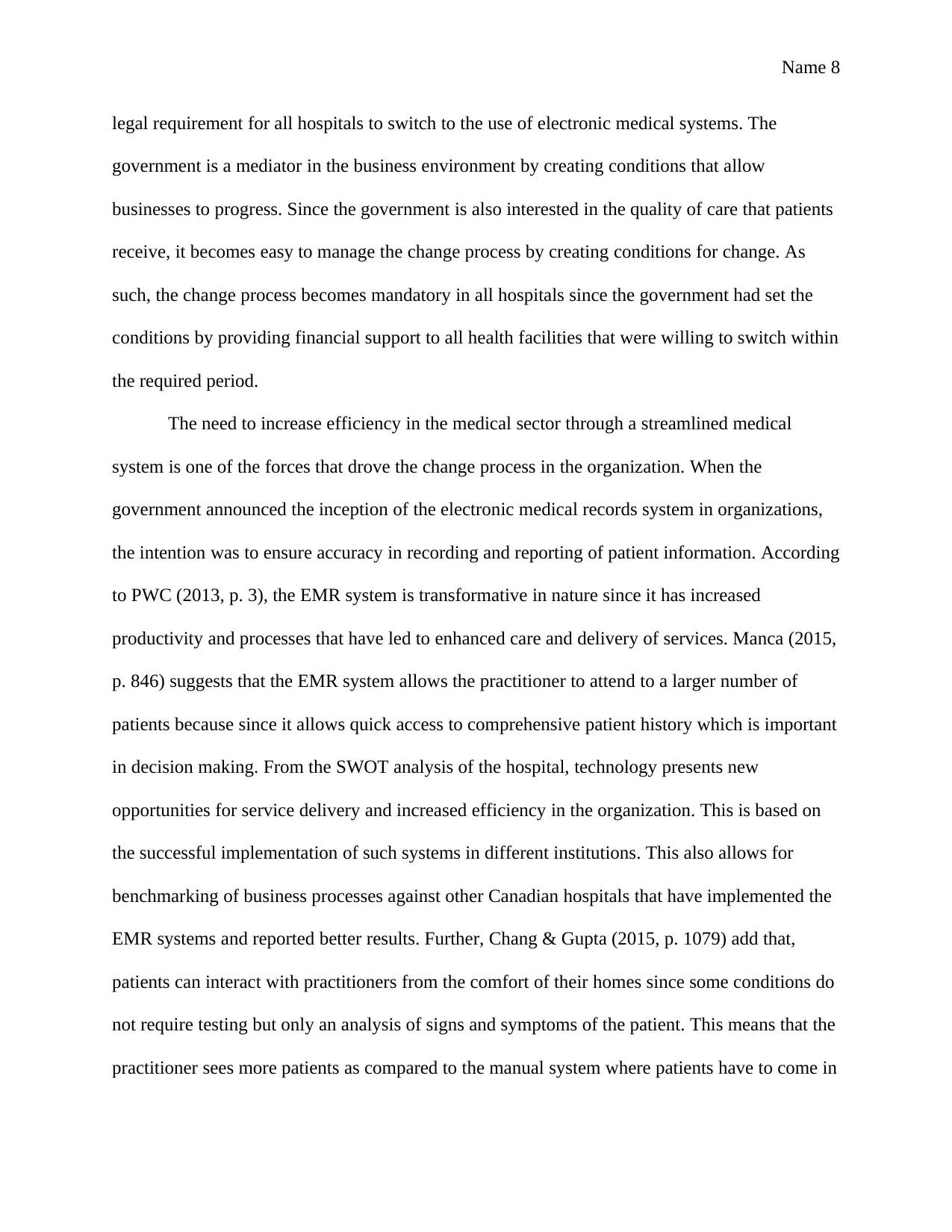
Name 8
legal requirement for all hospitals to switch to the use of electronic medical systems. The
government is a mediator in the business environment by creating conditions that allow
businesses to progress. Since the government is also interested in the quality of care that patients
receive, it becomes easy to manage the change process by creating conditions for change. As
such, the change process becomes mandatory in all hospitals since the government had set the
conditions by providing financial support to all health facilities that were willing to switch within
the required period.
The need to increase efficiency in the medical sector through a streamlined medical
system is one of the forces that drove the change process in the organization. When the
government announced the inception of the electronic medical records system in organizations,
the intention was to ensure accuracy in recording and reporting of patient information. According
to PWC (2013, p. 3), the EMR system is transformative in nature since it has increased
productivity and processes that have led to enhanced care and delivery of services. Manca (2015,
p. 846) suggests that the EMR system allows the practitioner to attend to a larger number of
patients because since it allows quick access to comprehensive patient history which is important
in decision making. From the SWOT analysis of the hospital, technology presents new
opportunities for service delivery and increased efficiency in the organization. This is based on
the successful implementation of such systems in different institutions. This also allows for
benchmarking of business processes against other Canadian hospitals that have implemented the
EMR systems and reported better results. Further, Chang & Gupta (2015, p. 1079) add that,
patients can interact with practitioners from the comfort of their homes since some conditions do
not require testing but only an analysis of signs and symptoms of the patient. This means that the
practitioner sees more patients as compared to the manual system where patients have to come in
legal requirement for all hospitals to switch to the use of electronic medical systems. The
government is a mediator in the business environment by creating conditions that allow
businesses to progress. Since the government is also interested in the quality of care that patients
receive, it becomes easy to manage the change process by creating conditions for change. As
such, the change process becomes mandatory in all hospitals since the government had set the
conditions by providing financial support to all health facilities that were willing to switch within
the required period.
The need to increase efficiency in the medical sector through a streamlined medical
system is one of the forces that drove the change process in the organization. When the
government announced the inception of the electronic medical records system in organizations,
the intention was to ensure accuracy in recording and reporting of patient information. According
to PWC (2013, p. 3), the EMR system is transformative in nature since it has increased
productivity and processes that have led to enhanced care and delivery of services. Manca (2015,
p. 846) suggests that the EMR system allows the practitioner to attend to a larger number of
patients because since it allows quick access to comprehensive patient history which is important
in decision making. From the SWOT analysis of the hospital, technology presents new
opportunities for service delivery and increased efficiency in the organization. This is based on
the successful implementation of such systems in different institutions. This also allows for
benchmarking of business processes against other Canadian hospitals that have implemented the
EMR systems and reported better results. Further, Chang & Gupta (2015, p. 1079) add that,
patients can interact with practitioners from the comfort of their homes since some conditions do
not require testing but only an analysis of signs and symptoms of the patient. This means that the
practitioner sees more patients as compared to the manual system where patients have to come in
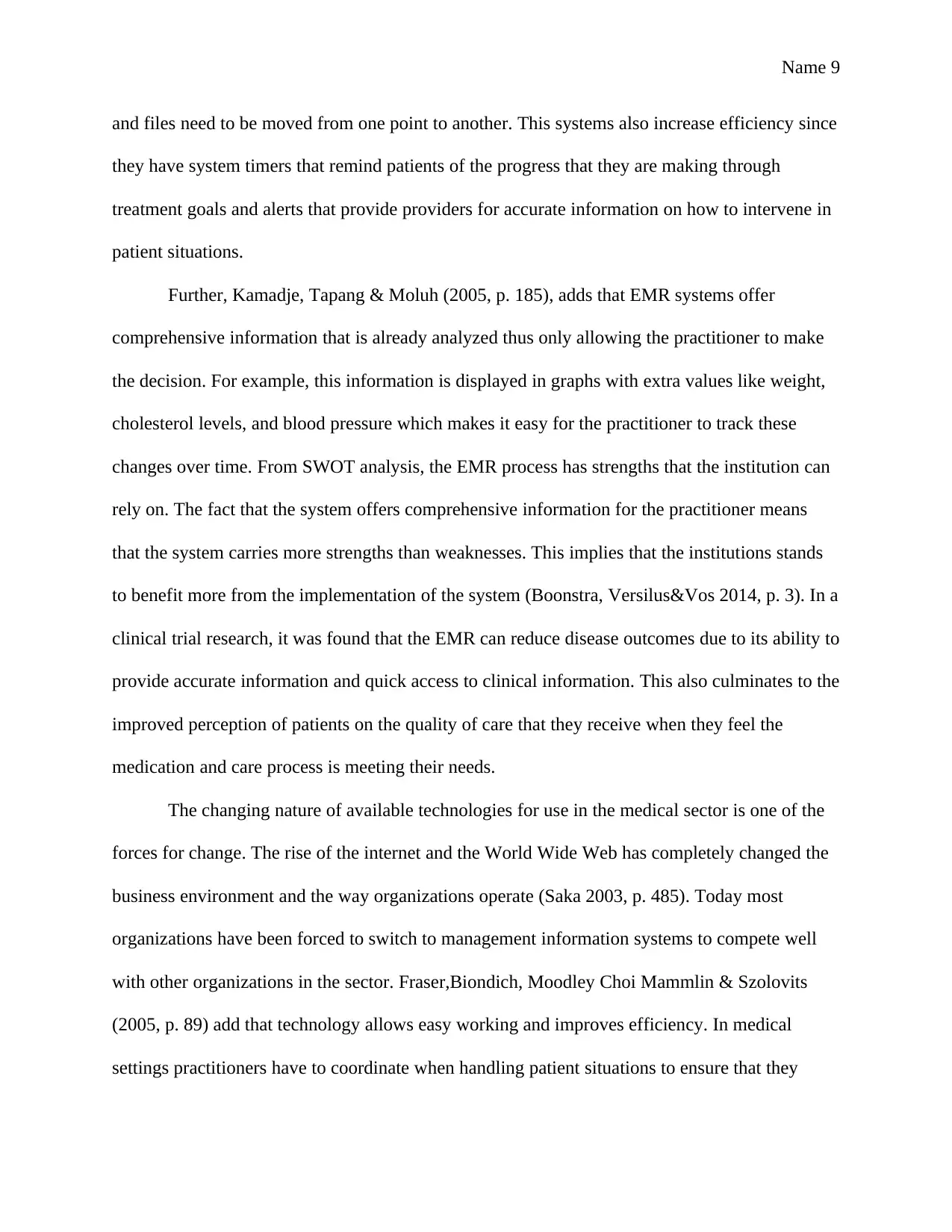
Name 9
and files need to be moved from one point to another. This systems also increase efficiency since
they have system timers that remind patients of the progress that they are making through
treatment goals and alerts that provide providers for accurate information on how to intervene in
patient situations.
Further, Kamadje, Tapang & Moluh (2005, p. 185), adds that EMR systems offer
comprehensive information that is already analyzed thus only allowing the practitioner to make
the decision. For example, this information is displayed in graphs with extra values like weight,
cholesterol levels, and blood pressure which makes it easy for the practitioner to track these
changes over time. From SWOT analysis, the EMR process has strengths that the institution can
rely on. The fact that the system offers comprehensive information for the practitioner means
that the system carries more strengths than weaknesses. This implies that the institutions stands
to benefit more from the implementation of the system (Boonstra, Versilus&Vos 2014, p. 3). In a
clinical trial research, it was found that the EMR can reduce disease outcomes due to its ability to
provide accurate information and quick access to clinical information. This also culminates to the
improved perception of patients on the quality of care that they receive when they feel the
medication and care process is meeting their needs.
The changing nature of available technologies for use in the medical sector is one of the
forces for change. The rise of the internet and the World Wide Web has completely changed the
business environment and the way organizations operate (Saka 2003, p. 485). Today most
organizations have been forced to switch to management information systems to compete well
with other organizations in the sector. Fraser,Biondich, Moodley Choi Mammlin & Szolovits
(2005, p. 89) add that technology allows easy working and improves efficiency. In medical
settings practitioners have to coordinate when handling patient situations to ensure that they
and files need to be moved from one point to another. This systems also increase efficiency since
they have system timers that remind patients of the progress that they are making through
treatment goals and alerts that provide providers for accurate information on how to intervene in
patient situations.
Further, Kamadje, Tapang & Moluh (2005, p. 185), adds that EMR systems offer
comprehensive information that is already analyzed thus only allowing the practitioner to make
the decision. For example, this information is displayed in graphs with extra values like weight,
cholesterol levels, and blood pressure which makes it easy for the practitioner to track these
changes over time. From SWOT analysis, the EMR process has strengths that the institution can
rely on. The fact that the system offers comprehensive information for the practitioner means
that the system carries more strengths than weaknesses. This implies that the institutions stands
to benefit more from the implementation of the system (Boonstra, Versilus&Vos 2014, p. 3). In a
clinical trial research, it was found that the EMR can reduce disease outcomes due to its ability to
provide accurate information and quick access to clinical information. This also culminates to the
improved perception of patients on the quality of care that they receive when they feel the
medication and care process is meeting their needs.
The changing nature of available technologies for use in the medical sector is one of the
forces for change. The rise of the internet and the World Wide Web has completely changed the
business environment and the way organizations operate (Saka 2003, p. 485). Today most
organizations have been forced to switch to management information systems to compete well
with other organizations in the sector. Fraser,Biondich, Moodley Choi Mammlin & Szolovits
(2005, p. 89) add that technology allows easy working and improves efficiency. In medical
settings practitioners have to coordinate when handling patient situations to ensure that they
⊘ This is a preview!⊘
Do you want full access?
Subscribe today to unlock all pages.

Trusted by 1+ million students worldwide

Name 10
share information from different points in the facility. This leads to improved patient care since
information is shared on time. On the other hand, the rise of mobile applications allows users to
access organizational information by creating their profiles within the system. This means that
technology is a factor that has pushed for digitizing of medical records to create an electronic
medical records system.
2.8 Forces against change
Existing organizational structures are the biggest challenge to any change process. The
functionalism approach sees the organization as being at an equilibrium stage because all
organizational functions are working together to achieve harmony (Stragalas 2010, p. 35). This
means that any change in the organization will destabilize the system and lead to conflict. A new
digitized system will mean changing from the manual system to a digitized system thus requiring
all practitioners to be equipped with relevant skills for meeting the needs of the organization.
Training consumes employee time since it requires them to learn how to use the new system
when they could not have done the same if the old system was in place. The reason why most
people resist change is that it destabilizes the organization culture and creates new conditions in
the organization (Parent & King 2015, p. 4). For example, the hospital has to formulate an
implementation plan that will ensure the employees shift from the old system to the new system.
For the system to work well, people have to be supported through the new system and a proper
change management framework to achieve the required goals.
Another force of change is the time taken to construct the new Epicare system by
capturing patient data from the manual system to the digital form. This transition takes time and
requires patience in management to ensure that the system works (Carberry & Cross 2015, p.
25). For example, the process was to take place in three phases because the project could not be
share information from different points in the facility. This leads to improved patient care since
information is shared on time. On the other hand, the rise of mobile applications allows users to
access organizational information by creating their profiles within the system. This means that
technology is a factor that has pushed for digitizing of medical records to create an electronic
medical records system.
2.8 Forces against change
Existing organizational structures are the biggest challenge to any change process. The
functionalism approach sees the organization as being at an equilibrium stage because all
organizational functions are working together to achieve harmony (Stragalas 2010, p. 35). This
means that any change in the organization will destabilize the system and lead to conflict. A new
digitized system will mean changing from the manual system to a digitized system thus requiring
all practitioners to be equipped with relevant skills for meeting the needs of the organization.
Training consumes employee time since it requires them to learn how to use the new system
when they could not have done the same if the old system was in place. The reason why most
people resist change is that it destabilizes the organization culture and creates new conditions in
the organization (Parent & King 2015, p. 4). For example, the hospital has to formulate an
implementation plan that will ensure the employees shift from the old system to the new system.
For the system to work well, people have to be supported through the new system and a proper
change management framework to achieve the required goals.
Another force of change is the time taken to construct the new Epicare system by
capturing patient data from the manual system to the digital form. This transition takes time and
requires patience in management to ensure that the system works (Carberry & Cross 2015, p.
25). For example, the process was to take place in three phases because the project could not be
Paraphrase This Document
Need a fresh take? Get an instant paraphrase of this document with our AI Paraphraser
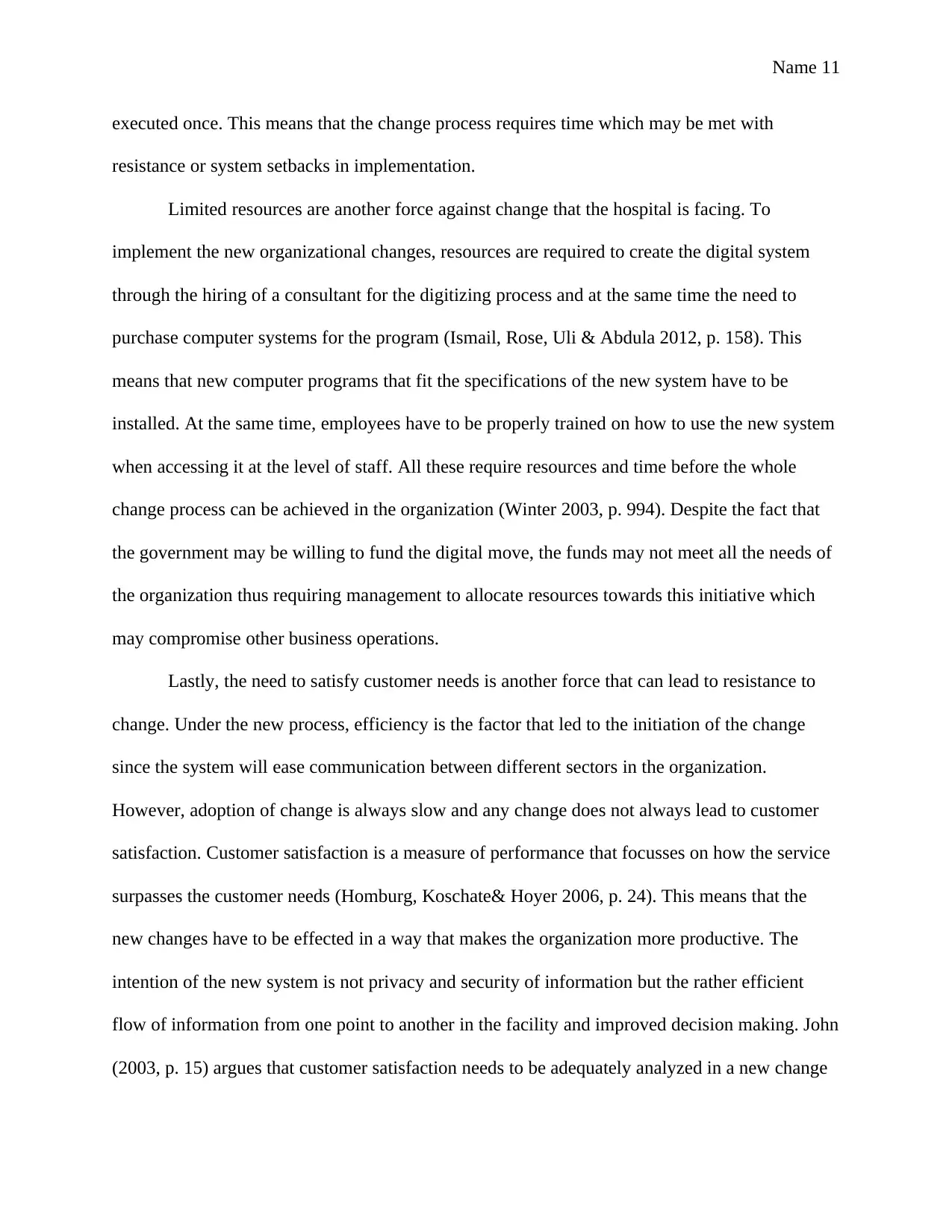
Name 11
executed once. This means that the change process requires time which may be met with
resistance or system setbacks in implementation.
Limited resources are another force against change that the hospital is facing. To
implement the new organizational changes, resources are required to create the digital system
through the hiring of a consultant for the digitizing process and at the same time the need to
purchase computer systems for the program (Ismail, Rose, Uli & Abdula 2012, p. 158). This
means that new computer programs that fit the specifications of the new system have to be
installed. At the same time, employees have to be properly trained on how to use the new system
when accessing it at the level of staff. All these require resources and time before the whole
change process can be achieved in the organization (Winter 2003, p. 994). Despite the fact that
the government may be willing to fund the digital move, the funds may not meet all the needs of
the organization thus requiring management to allocate resources towards this initiative which
may compromise other business operations.
Lastly, the need to satisfy customer needs is another force that can lead to resistance to
change. Under the new process, efficiency is the factor that led to the initiation of the change
since the system will ease communication between different sectors in the organization.
However, adoption of change is always slow and any change does not always lead to customer
satisfaction. Customer satisfaction is a measure of performance that focusses on how the service
surpasses the customer needs (Homburg, Koschate& Hoyer 2006, p. 24). This means that the
new changes have to be effected in a way that makes the organization more productive. The
intention of the new system is not privacy and security of information but the rather efficient
flow of information from one point to another in the facility and improved decision making. John
(2003, p. 15) argues that customer satisfaction needs to be adequately analyzed in a new change
executed once. This means that the change process requires time which may be met with
resistance or system setbacks in implementation.
Limited resources are another force against change that the hospital is facing. To
implement the new organizational changes, resources are required to create the digital system
through the hiring of a consultant for the digitizing process and at the same time the need to
purchase computer systems for the program (Ismail, Rose, Uli & Abdula 2012, p. 158). This
means that new computer programs that fit the specifications of the new system have to be
installed. At the same time, employees have to be properly trained on how to use the new system
when accessing it at the level of staff. All these require resources and time before the whole
change process can be achieved in the organization (Winter 2003, p. 994). Despite the fact that
the government may be willing to fund the digital move, the funds may not meet all the needs of
the organization thus requiring management to allocate resources towards this initiative which
may compromise other business operations.
Lastly, the need to satisfy customer needs is another force that can lead to resistance to
change. Under the new process, efficiency is the factor that led to the initiation of the change
since the system will ease communication between different sectors in the organization.
However, adoption of change is always slow and any change does not always lead to customer
satisfaction. Customer satisfaction is a measure of performance that focusses on how the service
surpasses the customer needs (Homburg, Koschate& Hoyer 2006, p. 24). This means that the
new changes have to be effected in a way that makes the organization more productive. The
intention of the new system is not privacy and security of information but the rather efficient
flow of information from one point to another in the facility and improved decision making. John
(2003, p. 15) argues that customer satisfaction needs to be adequately analyzed in a new change
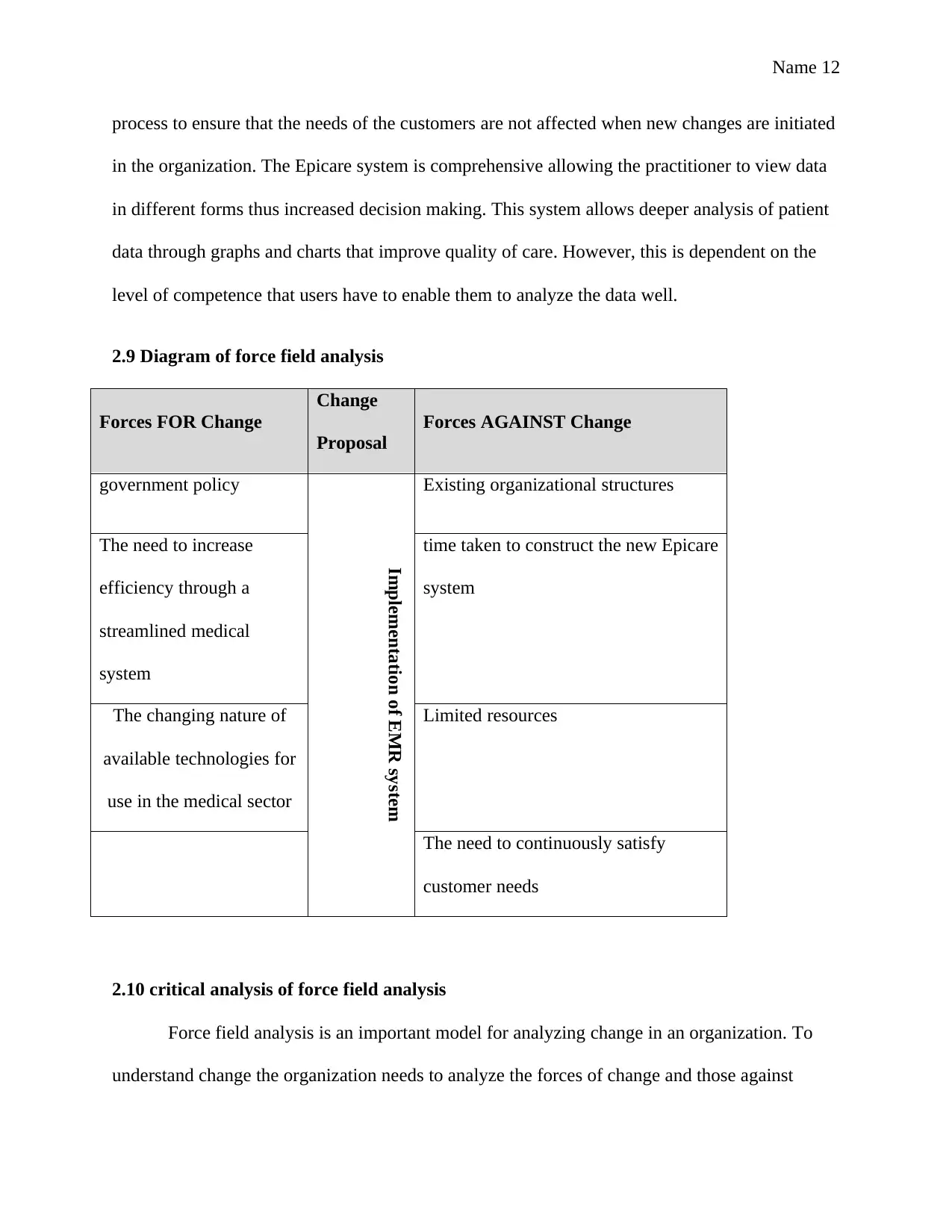
Name 12
process to ensure that the needs of the customers are not affected when new changes are initiated
in the organization. The Epicare system is comprehensive allowing the practitioner to view data
in different forms thus increased decision making. This system allows deeper analysis of patient
data through graphs and charts that improve quality of care. However, this is dependent on the
level of competence that users have to enable them to analyze the data well.
2.9 Diagram of force field analysis
Forces FOR Change
Change
Proposal
Forces AGAINST Change
government policy
Implementation of EMR system
Existing organizational structures
The need to increase
efficiency through a
streamlined medical
system
time taken to construct the new Epicare
system
The changing nature of
available technologies for
use in the medical sector
Limited resources
The need to continuously satisfy
customer needs
2.10 critical analysis of force field analysis
Force field analysis is an important model for analyzing change in an organization. To
understand change the organization needs to analyze the forces of change and those against
process to ensure that the needs of the customers are not affected when new changes are initiated
in the organization. The Epicare system is comprehensive allowing the practitioner to view data
in different forms thus increased decision making. This system allows deeper analysis of patient
data through graphs and charts that improve quality of care. However, this is dependent on the
level of competence that users have to enable them to analyze the data well.
2.9 Diagram of force field analysis
Forces FOR Change
Change
Proposal
Forces AGAINST Change
government policy
Implementation of EMR system
Existing organizational structures
The need to increase
efficiency through a
streamlined medical
system
time taken to construct the new Epicare
system
The changing nature of
available technologies for
use in the medical sector
Limited resources
The need to continuously satisfy
customer needs
2.10 critical analysis of force field analysis
Force field analysis is an important model for analyzing change in an organization. To
understand change the organization needs to analyze the forces of change and those against
⊘ This is a preview!⊘
Do you want full access?
Subscribe today to unlock all pages.

Trusted by 1+ million students worldwide
1 out of 17
Related Documents
Your All-in-One AI-Powered Toolkit for Academic Success.
+13062052269
info@desklib.com
Available 24*7 on WhatsApp / Email
![[object Object]](/_next/static/media/star-bottom.7253800d.svg)
Unlock your academic potential
Copyright © 2020–2025 A2Z Services. All Rights Reserved. Developed and managed by ZUCOL.




